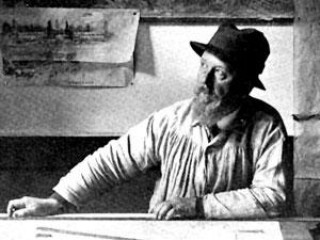
Bernard Maybeck biography
Date of birth : 1862-02-07
Date of death : 1957-10-03
Birthplace : New York City, U.S.
Nationality : American
Category : Arhitecture and Engineering
Last modified : 2022-02-07
Credited as : renowed architect, arts and crafts movement, university professor, Bernard Maybeck date of birth
0 votes so far
Maybeck was born in New York City, the son of a German immigrant and studied at the Ecole des Beaux Arts in Paris, France. He moved to Berkeley, California in 1892. He became a professor of engineering drawing at University of California, Berkeley and acted as a mentor for an entire generation of other California architects, including Julia Morgan and William Wurster. In 1951, he was awarded the Gold Medal of the American Institute of Architects.
Maybeck was equally comfortable producing work in the Mission style and Mission Revival style, Gothic revival, Arts and Crafts style, and Beaux-Arts classicism, believing that each architectural problem required development of an entirely new solution. Maybeck's contributions include the Mission Style California Building at the 1893 World's Columbian Exposition in Chicago and the first Mission Style chair designed for the San Francisco Swedenborgian Church.
Many of his buildings still stand in his long-time home city of Berkeley. The 1910 First Church of Christ, Scientist is designated a National Historic Landmark and is considered one of Maybeck's finest works. It is a strange confection of medieval European, Japanese, Nordic, Celtic and shingle style architecture, but the effect is magical. The church has an on-going program of repairs that have kept the building in good shape.
In 1914, Maybeck oversaw the building of the Maybeck Recital Hall in Berkeley, California. Maybeck also designed the domed Palace of Fine Arts in San Francisco as part of the 1915 Panama-Pacific International Exposition, and he carried out his vision of the lumberman's lodge, House of Hoo Hoo, made of little more than rough-barked tree trunks arranged in delicate harmony. The Palace of Fine Arts was seen as the embodiment of Maybeck's elaboration of how Roman architecture could fit within a California context. Maybeck said that the popular success of the Palace was due to the absence of a roof connecting the rotunda to the art gallery building, along with the absence of windows in the gallery walls and the presence near the rotunda of trees, flowers and a water feature.
One of Maybeck's most interesting office buildings is the home of the Family Service Agency of San Francisco, offices at 1010 Gough Street. This building, constructed in 1928, is on the city's Historic Building Register and still serves as Family Service headquarters. Some of his larger residential projects, most notably a few in the hills of Berkeley, California (see esp. La Loma Park), have been compared to the ultimate bungalows of the architects Greene and Greene.
He also developed a comprehensive town plan for the company town of Brookings, Oregon, a clubhouse at the Bohemian Grove, and many of the buildings on the campus of Principia College in Elsah, Illinois.
A number of his works are listed on the U.S. National Register of Historic Places.
A lifetime fascination with drama and the theatre can be seen in much of Maybeck's work. In his spare time, he was known to create costumes, and also designed sets for the amateur productions at Berkeley's Hillside Club.
Bernard Maybeck died in 1959 and is buried in the Mountain View Cemetery in Oakland, California.
















